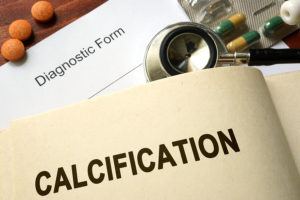Recently I’ve had several inquires about reversing vascular calcification. Is it possible? And if so how?  Today’s blog post will address this concern. The short answers to the above questions are:
Today’s blog post will address this concern. The short answers to the above questions are:
Yes, reversing vascular calcification is possible.
And the key ingredient is Vitamin K2.
It’s important to note that vascular calcification affects nearly 30% of Americans over the age of 45. And this percentage increases with age.
Why is Reversing Vascular Calcification Important
The mineral calcium is key to your overall health. As I pointed out in my blog article “How to Stop a Muscle Cramp at Night” calcium is needed to initiate any type of muscle contraction. And your bone health is dependent upon calcium absorption.
Additionally, the creation of nitric oxide, by the enzymes of the endothelium, is a calcium dependent reaction.
The problem is when calcium ends up in soft tissues like your arteries, heart valves, joints, breasts, kidneys, and brain; rather than in your bones where it belongs.
When this happens your soft tissue hardens and can’t function properly.
Vascular calcification leads to arterial stiffness, which then reduces the ability of your blood vessel to be flexible. This increases your resistance to blood flow and can be a contributing factor in elevating your blood pressure.
Vascular calcification is also an important predictor of cardiovascular disease. The greater the calcification the higher your risk for a heart attack.
Reversing Vascular Calcification Requires an Understanding of a Certain Protein
The human body is an amazingly well designed structure that when properly nourished can prevent most diseases from occurring. And when given the right ingredients your body is capable of healing itself.
How does this play out in reversing vascular calcification?
Well it has to do with a protein that lines our veins and arteries. It’s called Matrix Gla-protein or MGP. MGP prevents calcium from entering soft tissues, like your arteries and veins.
However, to be effective it must be activated. When activated it will bind to free-floating calcium. This prevents calcium from being deposited in soft tissues.
Without MGP activation, unbound calcium can enter the smooth muscles of the vascular wall leading to vascular calcification.
What’s the Key Ingredient in Preventing and Reversing Vascular Calcification
Vitamin K is the key ingredient but it has to be the correct form. And this is where most people get confused. There are two basic forms: K1 (phylloquinone) and K2 (menaquinone).
Vitamin K1 is found in leafy green vegetables like spinach and broccoli. It’s involved in regulating our body’s blood clotting ability. Which might be an issue with your physician if you’re on a blood-thinning medication.
Vitamin K2 is the correct form for preventing and reversing vascular calcification because it activates MGP. Vitamin K2 can be found in several forms:
Vitamin K2 (MK-4) – is found in grass-fed meat, eggs, and dairy products. It’s best know for its support of bone health but has a very short life span in your body.
Vitamin K2 (MK-7) – is found in fermented soybeans and fermented cheeses. It stays active for more than 24 hours and would be the preferred form of vitamin K2 for the prevention of vascular calcification.
Most people are deficient in their vitamin K2 levels. And as we age we also need more of this vitamin to help us maintain good vascular health.
There are multiple studies that clearly demonstrate the importance of vitamin K2 in your diet. The most famous one is the Rotterdam Study of 4807 Dutch men and women aged 55 and older. This study showed that those who had diets high in vitamin K2 reduced their risk for arterial calcification by 50%, cardiovascular death by 50%, and all causing of mortality by 25%.
The 2015 Knapen study of 244 postmenopausal women showed that high intake of vitamin K2 reduced and reversed arterial calcification.
Key Takeaways in Reversing Vascular Calcification
If you or a loved one has been diagnosed with vascular calcification, then talk with your physician about incorporating a vitamin K2 component into your daily routine. Research shows that this process can have a very beneficial outcome.
Here’s a summary of items to be aware of:
-
Vitamin K is fat-soluble so it is best taken with your fattiest meal of the day.
-
To be effective it must be vitamin K2 and the MK-7 form is best.
-
MK-7 is usually derived from soy so if you’re sensitive to soy then find a soy-free supplement form.
-
The amount taken varies but for most studies the amount ranged from 50 to 100 mg per day.
If you want a deeper dive into reversing vascular calcification then the following links will provide you with additional information.
https://cardiologydoc.wordpress.com/2013/01/18/vitamin-k2-and-vascular-disease/
Leave a Reply
You must be logged in to post a comment.